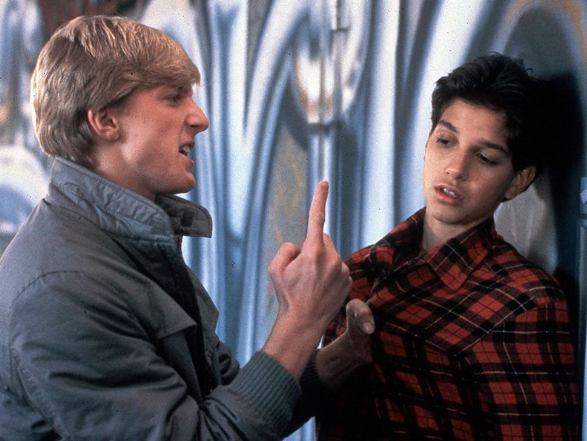For three years, I walked into Instructor Ken Strobel’s room, and saw a small poster on the wall that said, “Television has raised writing to a new low.” I wholeheartedly disagreed, and still disagree, with that statement. A lot of the writing on current television surpasses many recent films in quality. While there are some admittedly terrible shows on television, there are also many outstanding shows that audiences will argue as the best in the future. We are in an age of peak television. So, what separates the outstanding television shows from the subpar television shows that give television a trashy reputation? An outstanding television show has either flawed yet likable anti-heroes, groundbreaking feminist writing, an addictive, unrealistic concept, or a grand combination of these aspects; however, in order for a show to be truly outstanding, the show must also have an undeniable, underlying layer of humanity.
Anti-heroes are a huge part of the new peak television era. The audience is no longer interested in unrelatable, perfect protagonists. Instead, audiences prefer flawed, borderline-villainous anti-heroes. Quite a few of these series showcasing antiheroes are very skilled at conveying humanity amidst frightening situations. In The Americans, a fantastic, underrated show, the two lead characters, Elizabeth and Phillip Jennings, are Russians posing as Americans during the Cold War. Although viewers would naturally root against the Jennings, it’s also easy to understand why the Jennings are screwed up. They were both raised as children by their governments to manipulate others and were forcibly married in order to start a covert cover in America. Once the audience places themselves in the tampered minds of the Russians, the audience creates seemingly unlikely emotional connections to the Jennings.
Crazy Ex-Girlfriend and House of Cards both have other great examples of mostly likable anti-heroes. In Crazy Ex-Girlfriend, the protagonist flees her top-notch lawyer position in NYC to chase after her ex-boyfriend, from eighth grade, to West Covina, California. In House of Cards, the protagonist frequently makes impulsive, illegal decisions to ascend to power. On paper, a Russian-American spy, a crazy ex, and an unlawful Congressman are antagonists. However, through these shows, the antagonistic role is blurred as the perspectives of these characters are understood. The anti-heroic setup is a significant hallmark of recent peak television.
Another inspiring aspect of peak television is the expanded role of women, especially women in nontraditional roles. Not all women are housewives or secretaries or nurses. The key to truly understanding the greatness of new roles for women are the groundbreaking attitudes of many of the characters. Orange Is the New Black takes place in a women’s prison. The main character, Piper Chapman, is only in prison for a 15-month stint due to a drug trafficking incident that happened 10 years prior to the start of the series. However, the audience quickly realizes that the show is actually about all the inmates of Litchfield Penitentiary.
Many of the characters have colorful pasts that don’t match with their exterior. Crazy Eyes, AKA Suzanne Warren, is discarded as a lunatic by her fellow inmates. The series slowly reveals that Suzanne was adopted as a child because her adoptive parents could not have kids. Then, her adoptive parents had a miracle child, which led to Suzanne fighting for attention that she could not win over. There’s a central part of Suzanne that never grew up because she was so ignored by everyone. The tragic depiction of Suzanne’s character would seem much more unexpected twenty years ago because the topic of questionable mental health wasn’t acknowledged as prominently as it is today. The unique role of Suzanne illustrates a rarely seen side of a woman on television.
Other shows with strong feminist attitudes are Marvel’s Jessica Jones and Girls. Jessica Jones follows the titular character struggling with PTSD while learning to use her superpowers to better the world. Her attitude is extremely cynical, which is highly unexpected for a woman . Girls is a show about four snobby young women living in NYC. The main character, Hannah Horvath, is a raging narcissist that has constant impulsive tendencies. Her unlikeability is actually what makes her a true feminist character because layered, unlikeable women are not usually present on television. True feminist writing like the writing present in these shows are prime examples of recent peak television.
While well-written shows with anti-heroes and feminist attitudes are welcome, the perhaps most compelling showcase of outstanding television writing include the out-there conceptual shows grounded in realism. The Leftovers takes place in a dystopian future where 2% of the world’s population unexpectedly vanished in thin air. The center of The Leftovers is the once-happy Garvey family of four. The Garvey family didn’t actually lose any members in the catastrophic event, referred to as the Sudden Departure. However, the family still breaks apart as the mother joins a cult that warns people not to forget the Sudden Departure. The Leftovers embraces this absurdity through further crazy events. The series may not always make logical sense, but the characters do because they are human, and the characters make realistic logical decisions.
Jane the Virgin and BoJack Horseman are two other phenomenal shows with unrealistic concepts and powerful stories. Jane the Virgin follows a young woman, a virgin, who is accidentally artificially inseminated by a seriously under-qualified medical professional. The show utilizes a traditional telenovela setup, but the show itself is aware of its ridiculousness, poking fun at the premise weekly. BoJack Horseman takes place in an anthropomorphic world. BoJack Horseman follows the titular character on a journey to make a comeback after his fame in a forgettable ‘90s sitcom. BoJack suffers from serious depression which adds to the story’s emotional weight. Creative, unrealistic concepts often lead to great shows like these.
The peak era of television is undeniable. The small poster on the wall of Mr. Strobel’s room is clearly outdated. There are so many great series out there that allow the audience to connect on multiple levels beyond the simple understanding-the-story level. There is a significant difference between subpar television and great television, and the greatest way to tell the difference is to examine whether there is an underlying layer of humanity.






